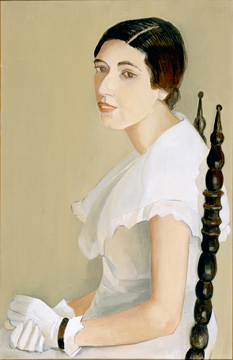Josephine Crawford
In the first half of the twentieth century, painter Josephine Crawford helped introduce the New Orleans artistic community to modernism.

Courtesy of The Historic New Orleans Collection
"Young Woman Wearing White Gloves". Crawford, Josephine Marien (Artist)
In the first half of the twentieth century, painter Josephine Crawford helped introduce the New Orleans artistic community to modernism. Though she did not begin painting until relatively late in life, Crawford took her work seriously, studying with well-known artists in Paris and Vienna before returning to New Orleans. Her distinctive style, always recognizable, assimilated cubism with the flattened forms of modernism. Along with Paul Ninas and Will Henry Stevens, she helped challenge impressionism as the dominant style among New Orleans artists.
Born December 31, 1878, Josephine Marien Crawford was the daughter of Charles Campbell Crawford and Louise Bienvenu Crawford of New Orleans. The sixth of nine children, she grew up speaking both French and English. She learned the former from her mother, a descendant of the Bienvenus who settled in Louisiana in the 1700s. Crawford’s maternal grandfather, François Mélicourt Bienvenu, purchased the family’s French Quarter townhouse in 1839. Her father’s family came from Belfast in Northern Ireland.
At first, Crawford’s creative spirit found expression in poems about her large family and her surroundings in the French Quarter, where she lived at 612 Royal Street. The Royal Street house with its porte cochère, courtyard, winding staircase, and high ceilings figured prominently in Crawford’s poems and was instrumental in refining her artistic sensibilities. Her creativity was further enriched by sojourns in Biloxi on the Mississippi Gulf Coast, a place she returned to throughout her life. Crawford studied at the Cenas Institute for Young Ladies, McDonogh High School No. 3, and briefly at Newcomb College where she enrolled in 1895. It was not until the 1920s that she began studying art formally, enrolling in classes at the newly opened school of the Arts and Crafts Club. Located at 520 Royal Street, the school was just one block from her house.
In the winter of 1927–28, a pivotal time in her artistic development, Crawford studied with André Lhote at his academy in Paris. That spring she continued her studies in Vienna at the Kunstgewerbeschule. Crawford’s studies in Europe strongly influenced the development of her artistic style. While the work of most New Orleans artists reflected the continued popularity of Impressionism, she was influenced by modernism, especially cubism. Crawford’s paintings present unique artistic interpretations rather than true-to-life representations, without ever becoming completely abstract. Her muted color palette of grays and variations of white give her paintings a characteristic quietness.
After her studies in Europe, Crawford returned to her home in New Orleans where she continued to paint. If her distinctive style placed her outside New Orleans’s artistic mainstream, it also earned her critical acclaim. In 1934, she won the Arts and Crafts Club’s prestigious Blanche Benjamin Prize for Rue Kerlerec, an evocative portrait of a Creole widow, and the club held a one-woman show of her work in 1940. Crawford also created paintings for the Public Works of Art Project, the first of the New Deal art programs. At home, she engaged in a personal endeavor: painting large portraits of family members on the wallpaper of the parlor, which also served as her studio. Besides exhibiting in New Orleans, Crawford’s work was included in exhibitions in New York, Philadelphia, and Central America.
Following her death on March 24, 1952, her brother left a large collection of her work—together with her sketchbooks, personal papers, and poetry—to The Historic New Orleans Collection.
